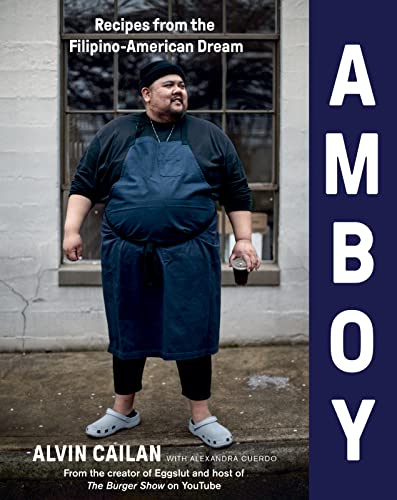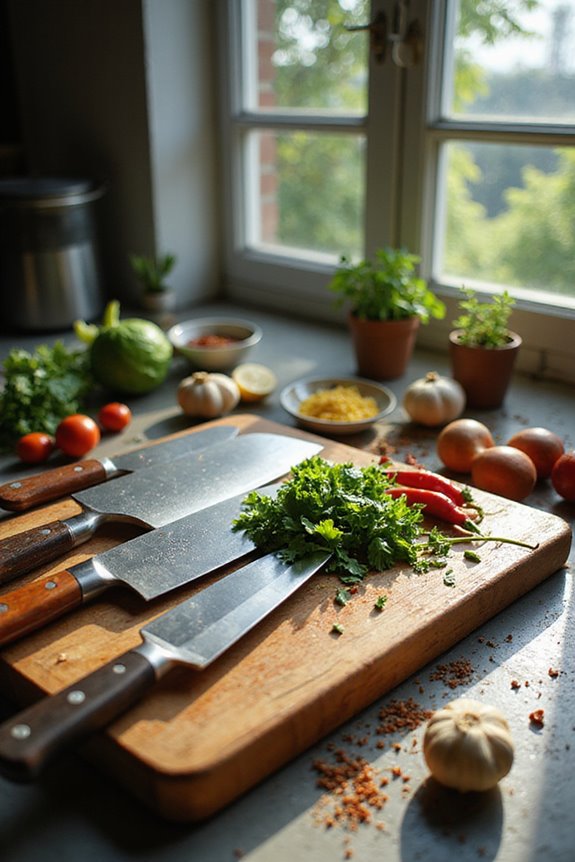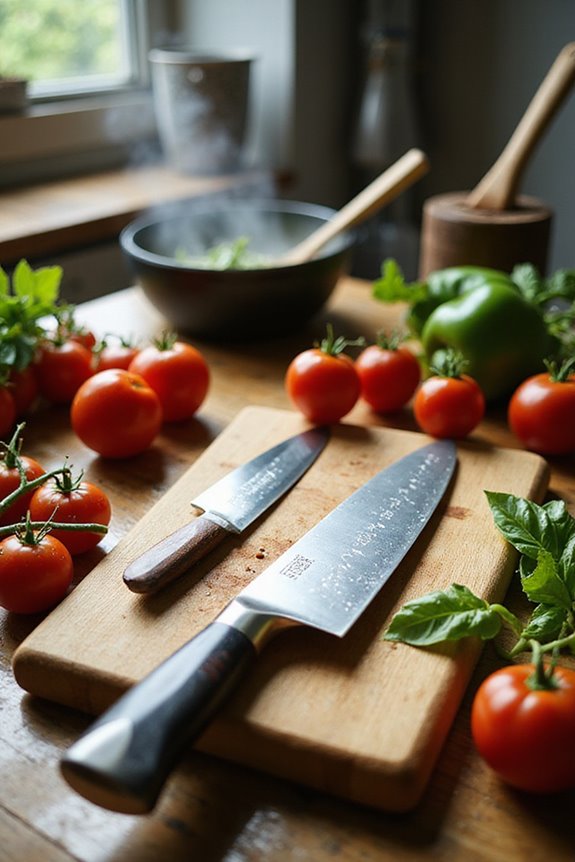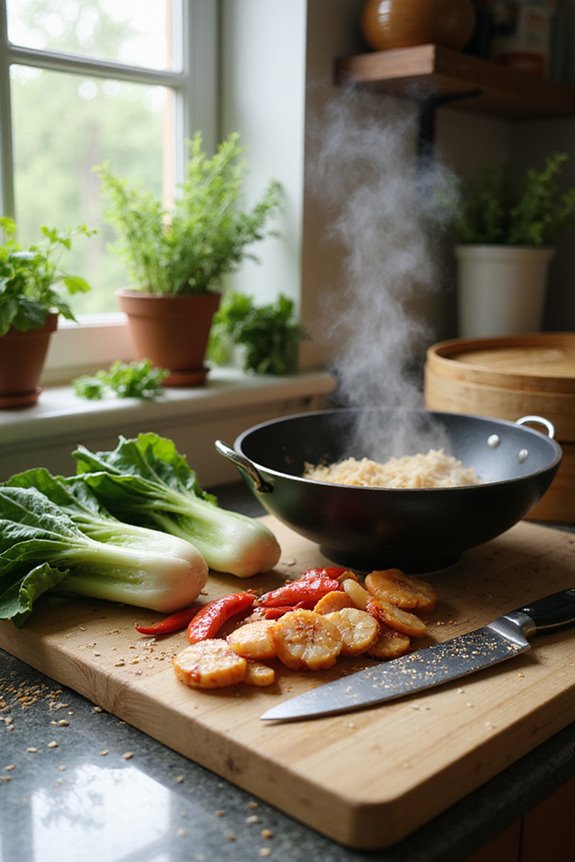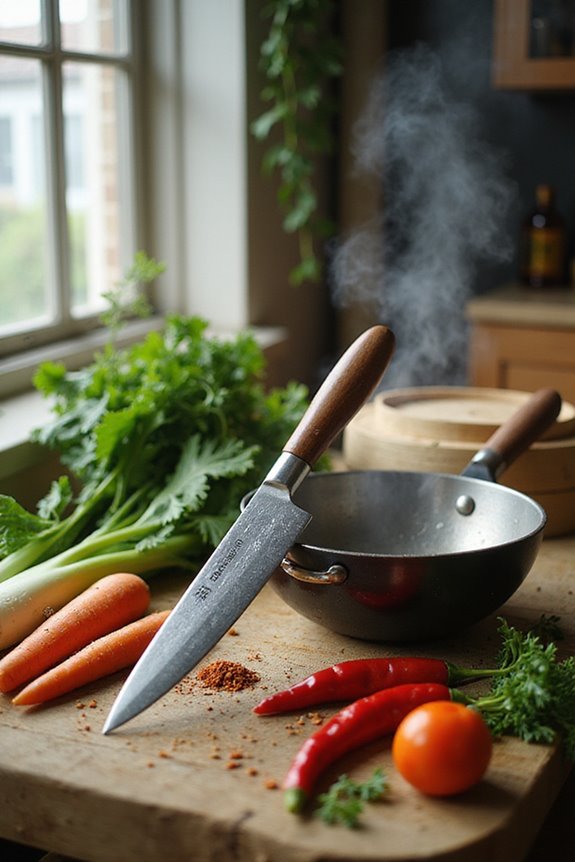As an Amazon Associate, we earn from qualifying purchases. Some links may be affiliate links at no extra cost to you. Although our opinions are based on curated research, we haven't used these products. Articles generated with AI.
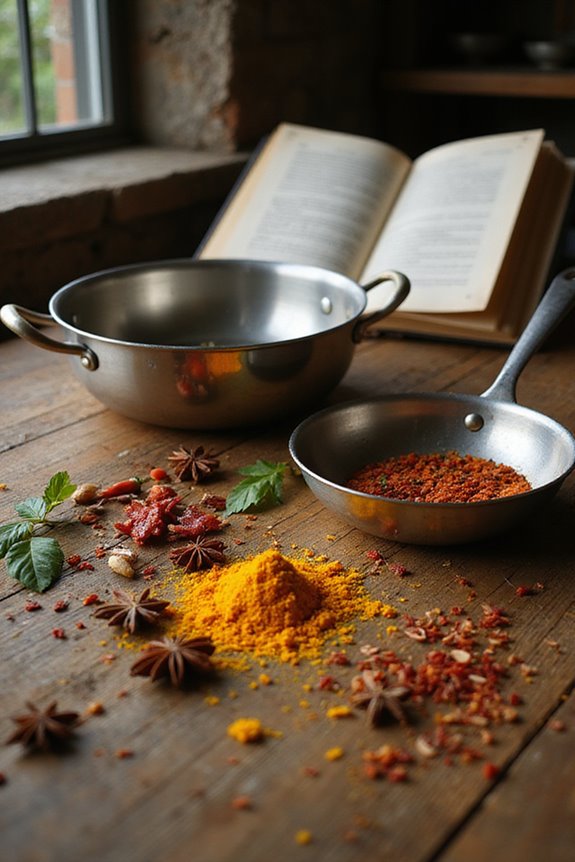
5 Best Filipino Cookbooks for Comfort Food That Will Warm Your Heart and Home
If you’re looking for heartwarming Filipino comfort food, check out these five cookbooks: “Cooking Like A Filipino” offers simple recipes, while “Sugarcane” combines stories with delightful dishes. The “Filipino Instant Pot Cookbook” is perfect for busy cooks, and “Amboy” reflects the Filipino-American experience. If you’re health-conscious, “Ay Sus!” provides plant-based alternatives. Each book brings unique flavors and insights. Stick around, and you’ll discover even more about the vibrant world of Filipino cooking.
Key Takeaways
- Sugarcane: Sweet Recipes from My Half-Filipino Kitchen offers comforting, home-cooked recipes combined with personal storytelling for a heartwarming experience.
- Filipino Cookbook: Cooking Like A Filipino introduces authentic techniques and simple recipes, making it a great resource for those exploring traditional Filipino cuisine.
- The Filipino Instant Pot Cookbook provides quick, classic, and modern recipes with clear instructions, perfect for busy individuals who crave comfort food.
- Amboy: Recipes from the Filipino-American Dream delivers beloved dishes with rich cultural insights and user-friendly navigation, ideal for family-centric meals.
- Ay Sus!: Whole Food Plant-Based Global Filipino Cuisine revises traditional recipes for health-focused diets, making comfort food accessible without compromising culinary heritage.
Filipino Cookbook: Cooking Like A Filipino
Filipino Cookbook, Cooking Like A Filipino : 50 More Easy And Simple To Make Filipino Recipes
- Amazon Kindle Edition
- Del Castillo, Lucas (Author)
- English (Publication Language)
If you’re looking to immerse yourself in the rich and vibrant world of Filipino cuisine, the “Filipino Cookbook: Cooking Like A Filipino” is an excellent choice for you. With 50 easy and simple recipes, this book makes authentic Filipino cooking accessible. It introduces you to traditional techniques, while also offering alternative methods for various dishes, ensuring versatility in your cooking approach. You’ll appreciate the personal touch, as it resonates with those who have a long-standing interest in Filipino food. Highly recommended for anyone enthusiastic to explore and learn, this cookbook is perfect for enhancing your culinary repertoire with comforting Filipino flavors.
Best For: Individuals interested in exploring and learning authentic Filipino cooking techniques and recipes.
Pros:
- Provides 50 easy-to-follow recipes that cater to various skill levels.
- Includes traditional techniques along with alternative cooking methods.
- Perfect for enhancing your culinary repertoire with authentic Filipino flavors.
Cons:
- May not include extensive information on regional variations of Filipino cuisine.
- Some recipes might require hard-to-find ingredients for those outside the Philippines.
- Limited focus on advanced cooking techniques or gourmet Filipino dishes.
Sugarcane: Sweet Recipes from My Half-Filipino Kitchen
Sale
Sugarcane: Sweet Recipes from My Half-Filipino Kitchen
- Hardcover Book
- Osborne, Arlyn (Author)
- English (Publication Language)
For those looking to explore the rich flavors of Filipino cuisine while enjoying comforting, home-cooked meals, “Sugarcane: Sweet Recipes from My Half-Filipino Kitchen” stands out as an excellent choice. This cookbook beautifully combines personal storytelling with a diverse collection of recipes drawn from the author’s heritage. You’ll discover various delightful dishes that honor Filipino traditions and showcase her creative approach to cooking. Not only is the book a joy to read, but it also adds visual appeal to your kitchen. It invites you to connect with Filipino culture through food, making every recipe a heartfelt experience.
Best For: Those seeking to explore Filipino cuisine through comforting, home-cooked recipes enriched with personal storytelling.
Pros:
- Diverse Recipes: Offers a variety of dishes that celebrate Filipino flavors and traditions.
- Personal Touch: The author’s heartfelt narratives enhance the cooking experience, making it more meaningful.
- Aesthetic Design: The visually appealing layout makes it a beautiful addition to any kitchen or bookshelf.
Cons:
- Limited Audience: Those unfamiliar with Filipino cuisine may find some ingredients or cooking methods challenging.
- Specialty Ingredients: Certain recipes may require hard-to-find ingredients that could limit accessibility.
- Focus on Sweets: Primarily a dessert-oriented cookbook, which may not appeal to all home cooks looking for savory options.
The Filipino Instant Pot Cookbook
Sale
The Filipino Instant Pot Cookbook: Classic and Modern Filipino Recipes for Your Electric Pressure...
- Domingo, Tisha Gonda (Author)
- English (Publication Language)
- 174 Pages - 10/29/2019 (Publication Date) - Rocketships & Wonderment (Publisher)
The Filipino Instant Pot Cookbook stands out as an essential guide for both novice cooks enthusiastic to explore Filipino cuisine and experienced chefs wanting to streamline their cooking process. Packed with classic and modern recipes, this cookbook shines with clear instructions that make cooking traditional dishes like adobo and sinigang accessible. You’ll discover insightful cultural stories, personal anecdotes, and helpful historical tidbits that enhance your cooking journey. While some adjustments may be necessary for ideal sauce consistency, you’ll appreciate how quickly the Instant Pot transforms ingredients into comforting meals—all while bringing a taste of home straight to your table.
Best For: This cookbook is best for novice cooks eager to explore Filipino cuisine and experienced chefs looking to simplify traditional cooking methods.
Pros:
- Features authentic Filipino recipes that cater to a wide range of palates, including lesser-known dishes.
- The Instant Pot significantly reduces cooking time, making it perfect for busy individuals and families.
- Clear instructions and engaging storytelling enhance the cooking experience and strengthen cultural connections.
Cons:
- Some recipes may require adjustments to water ratios for optimal sauce consistency.
- Ingredients availability may pose challenges for users in certain regions.
- Minor tweaks in cooking times may be necessary to achieve the best results.
Amboy: Recipes from the Filipino-American Dream
Sale
Amboy: Recipes from the Filipino-American Dream
- Hardcover Book
- Cailan, Alvin (Author)
- English (Publication Language)
“Amboy: Recipes from the Filipino-American Dream” stands out as an essential addition to your kitchen, especially if you seek to explore authentic Filipino cuisine with ease and flair. Created by chef Alvin Cailan, this cookbook features user-friendly navigation, allowing you to seamlessly access sections and recipes. You’ll appreciate the clear instructions for beloved dishes like Pan de Sal and Adobo. The author shares personal cooking techniques while reflecting on his Filipino-American journey, connecting you to rich cultural traditions. With warm photography and practical tips, “Amboy” helps you recreate comforting meals while celebrating your heritage through food.
Best For: Those seeking an engaging introduction to authentic Filipino cuisine with accessible recipes and cultural insights.
Pros:
- User-friendly navigation allows seamless access to recipes and sections, enhancing the cooking experience.
- Includes detailed instructions and practical cooking tips, making it suitable for both novice and experienced cooks.
- Rich cultural insights and personal storytelling create a deeper connection to Filipino heritage.
Cons:
- Some users reported damaged copies upon delivery, indicating potential quality control issues.
- There have been mentions of broken navigation links in certain versions, which might hinder accessibility.
- Cooking certain ingredients, like Jasmine rice, can pose challenges for those unfamiliar with the cuisine.
Ay Sus!: Whole Food Plant-Based Global Filipino Cuisine
Ay Sus!: Whole Food Plant-Based Global Filipino Cuisine
- Martinez, Cleodia (Author)
- English (Publication Language)
- 120 Pages - 04/05/2021 (Publication Date) - Absolute Catering & Events, Inc. (Publisher)
If you’re looking to explore the rich flavors of Filipino cuisine while adhering to a whole food plant-based diet, “Ay Sus!: Whole Food Plant-Based Global Filipino Cuisine” might just be the cookbook for you. This book offers a delightful selection of revised traditional recipes that cater to your dietary needs, ensuring familiar flavors are accessible for both Filipinos and non-Filipinos alike. You’ll find numerous comfort food options, complete with easy-to-follow instructions and appealing pictures. Although some classic dishes are missing and the eBook may present accessibility challenges, it still serves as a great resource for reconnecting with your culinary heritage.
Best For: Individuals looking to enjoy traditional Filipino flavors while following a whole food plant-based diet, including those with dietary restrictions.
Pros:
- Offers a variety of revised traditional Filipino recipes that cater to a whole food plant-based lifestyle.
- Includes easy-to-follow instructions and appealing pictures, making it accessible for readers of all cooking levels.
- Helps readers reconnect with their culinary heritage in a healthier way.
Cons:
- Some classic Filipino dishes are notably missing from the cookbook, such as ginataan and palabok.
- The eBook format poses accessibility challenges, particularly for users with vision impairments.
- The book’s thinness may indicate gaps in recipe offerings compared to more comprehensive cookbooks.
Factors to Consider When Choosing Filipino Cookbook Comfort Food
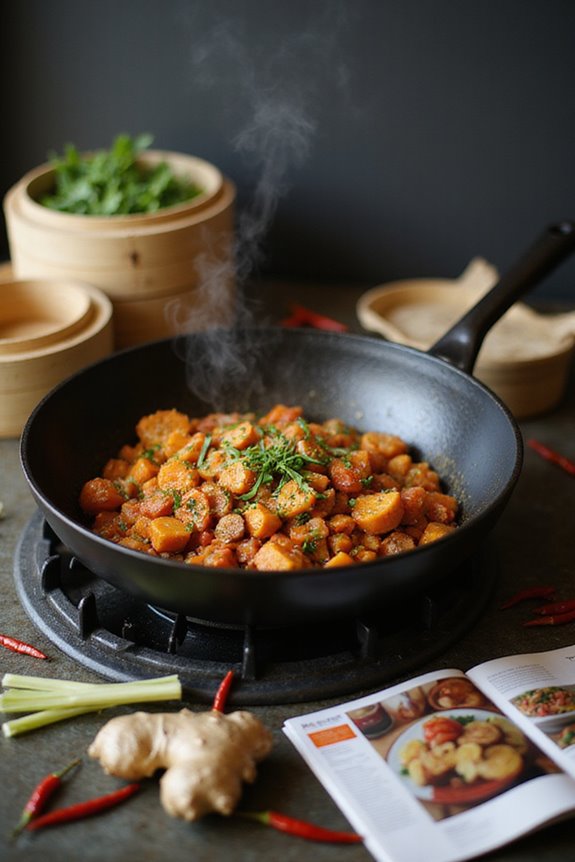
When you’re choosing a Filipino cookbook for comfort food, consider a few key factors. Look for recipes that reflect authenticity, offer a variety of cooking techniques, and align with your audience’s cooking skills. It’s also important to think about cultural significance and any dietary needs you might have, as these can shape your cooking experience and enjoyment.
Recipe Authenticity
Choosing a Filipino cookbook that captures the essence of comfort food requires careful evaluation of several factors, especially regarding recipe authenticity. Look for cookbooks that highlight traditional cooking methods, ensuring you feel the cultural heritage in every dish. Recipes should use authentic Filipino ingredients, like bagoong and patis, to deliver true flavors. Personal anecdotes or historical context can greatly enhance the connection to each dish’s significance. Don’t forget to take into account variations in regional cuisine; an excellent cookbook celebrates these differences while offering clear instructions. In addition, recipes adapted for modern methods, such as Instant Pot variations, can still be authentic, making your cooking experience both enjoyable and culturally enriching.
Cooking Techniques Variety
Cooking techniques play a pivotal role in recreating the comforting flavors of Filipino cuisine, making it essential to choose a cookbook that offers a broad variety. Look for cookbooks that showcase traditional methods like sautéing (ginisa), boiling (pakuluan), and braising (nilaga). These techniques are crucial for authentic comfort food. Additionally, consider books that include alternative cooking methods, like using an Instant Pot or slow cooker, to fit your lifestyle. Detailed step-by-step instructions can help novice cooks tackle complex dishes, such as kare-kare or adobo. It’s also beneficial to find cookbooks that highlight grilling (inihaw), steaming (pinaupong), and frying (pritong) to explore diverse flavors. User-friendly tips on ingredient substitutions make Filipino cooking accessible for everyone.
Audience Cooking Skills
How confident do you feel in your cooking abilities? When selecting a Filipino cookbook, assess your skills. Some cookbooks cater to beginners with straightforward recipes, while others plunge into intricate techniques. Look for clear, detailed instructions that guide you through traditional dishes; this is especially helpful if you’re new to cooking. Consider cookbooks that offer tips on ingredient substitutions and preparation methods, making it easier to navigate unfamiliar Filipino flavors. A variety of recipes—both simple and complex—can help build your confidence in the kitchen. Additionally, personal anecdotes and cultural context enrich your experience, motivating you to explore and improve your culinary skills. Choose wisely, and find a cookbook that suits your cooking journey.
Cultural Significance
Exploring Filipino cookbooks extends beyond just recipes; it offers a glimpse into the rich cultural tapestry that shapes each dish. When choosing a cookbook, consider how it incorporates personal narratives and historical influences that highlight the significance of Filipino cuisine. You’ll find that comfort food often brings back fond memories of family gatherings and cherished traditions. Pay attention to cookbooks that use locally sourced ingredients and traditional methods, as these elements emphasize a deep connection to the land and community. Additionally, a good cookbook will educate you about the diverse flavors and cultural heritage while promoting cross-cultural understanding. This way, you’re not just cooking; you’re immersing yourself in the heart and soul of Filipino culture.
Dietary Considerations
What should you keep in mind when selecting a Filipino cookbook for comfort food? Start by checking if the recipes cater to dietary restrictions, like vegetarian, vegan, or gluten-free. Traditional dishes can be high in fat and calories, so seek cookbooks that provide lighter options or whole food plant-based alternatives. It’s also important to look for cookbooks that suggest ingredient substitutions, especially for traditional items like fish sauce, which might not align with your preferences. Additionally, consider the level of detail in nutritional information offered for each recipe; this helps you understand the health implications of your choices. Ultimately, choosing a cookbook that fits your dietary needs will make your cooking experience more enjoyable and rewarding.
Ingredient Availability
Ingredient availability plays an essential role when choosing a Filipino cookbook for comfort food, and understanding this can greatly enhance your cooking experience. Many traditional recipes call for unique items like bagoong or fresh produce, which may not be easy to find in every region. Some cookbooks do offer alternative ingredient suggestions, expanding accessibility. Familiarizing yourself with local markets that specialize in Asian products can improve your chances of recreating authentic dishes. Furthermore, knowing which recipes depend on seasonal ingredients, like tropical fruits, can affect how practically you can cook from your chosen book. This knowledge guarantees you enjoy the cooking process without excessive frustration or ingredient hunting.
Visual Appeal
A visually appealing Filipino cookbook can transform your cooking experience, making it not just about following recipes but also enjoying the process. Look for vibrant photography that showcases the rich colors and textures of traditional dishes; this can elevate your culinary motivation. A well-designed layout with clear organization and headings allows you to navigate recipes quickly, making it easier to find your comfort food favorites. Cookbooks that feature aesthetically pleasing images of finished dishes can truly inspire you to recreate those meals. Additionally, when personal stories or cultural context accompany the images, they deepen your engagement with the recipes. A beautiful cookbook doesn’t just guide you; it can also enhance your kitchen’s decor, serving a dual purpose.
Personal Connection
When choosing a Filipino cookbook for comfort food, consider how the recipes resonate with your personal experiences. A cookbook that shares stories or cultural narratives can create a stronger emotional connection, making the dishes feel more authentic. Look for recipes that reflect the author’s culinary journey, inspiring you to explore your ties to Filipino food. Cookbooks that highlight personal experiences encourage intimacy with the recipes, allowing you to connect with your heritage through cooking. Nostalgic storytelling can evoke memories of family gatherings or special occasions, fostering a desire to recreate those beloved dishes. Ultimately, the right cookbook can transform your cooking into a meaningful exploration of culture and personal identity.
Frequently Asked Questions
What Are the Essential Ingredients in Filipino Comfort Food?
To create authentic Filipino comfort food, you’ll need essential ingredients like garlic, onions, and soy sauce, which form the flavor base. Rice is a staple, accompanying most dishes. Incorporating meats like chicken, pork, or beef, and seafood enriches your meals. Don’t forget vegetables like bitter melon or eggplant, which add texture. Finally, keep vinegar and chili peppers handy; they enhance depth and spice, completing the comforting experience of Filipino cuisine.
How Can I Adapt Recipes for Dietary Restrictions?
Adapting recipes for dietary restrictions is like tailoring a suit; you want it to fit perfectly. Start by identifying allergens and nutritional needs. Swap out specific ingredients, such as using almond milk instead of cow’s milk or quinoa instead of rice. Adjust cooking times as needed, and always taste as you go. Don’t shy away from experimenting—this will help you create versions of your favorite dishes that everyone can enjoy without compromising flavor.
Are There Beginner-Friendly Filipino Cookbooks Available?
Yes, there are several beginner-friendly Filipino cookbooks available. Look for titles that emphasize simple recipes, like “Filipino Food Any Day” by reynaldo james or “The Filipino Cookbook” by Angelina B. This way, you’ll find clear instructions and accessible ingredients. These cookbooks often provide helpful tips and variations for beginners, ensuring you gain confidence in your cooking. You’ll enjoy dishes like adobo or sinigang without feeling overwhelmed, making your culinary journey rewarding.
Can I Find Gluten-Free Filipino Recipes?
Absolutely, you can find gluten-free Filipino recipes! Many classic dishes can be easily adapted by substituting ingredients. For example, you might use rice flour instead of regular flour for your lumpia or skip the soy sauce for a gluten-free alternative. Online communities and cookbooks specifically focus on gluten-free Filipino cuisine, providing a treasure trove of options. With a little creativity, you’ll enjoy the flavors without compromising on dietary needs. Immerse yourself and explore!
How Do I Store Leftovers From Filipino Dishes?
To store leftovers from Filipino dishes, let them cool completely before putting them in airtight containers. Make certain you label each container with the date and contents for easy identification. Most dishes can be refrigerated for 3 to 4 days; for longer storage, freezing is best. You should thaw frozen leftovers in the fridge overnight before reheating. When reheating, verify the food reaches an internal temperature of 165°F for safety.




